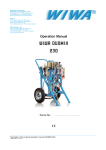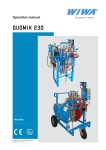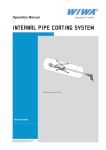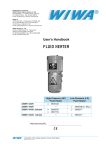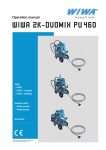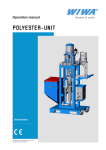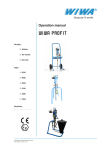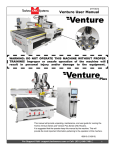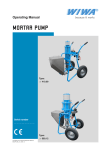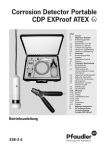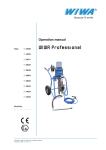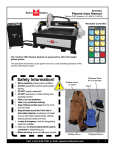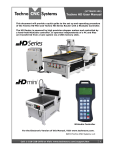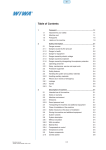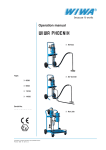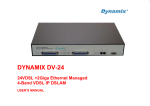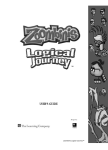Download Manual
Transcript
Hauptsitz und Produktion / Headquarter & Production: WIWA Wilhelm Wagner GmbH & Co. KG Gewerbestraße 1 – 3 • 35633 Lahnau, Germany Tel +49 64 41-6 09-0 • Fax +49 64 41-6 09-50 E-mail: [email protected] • Internet: www.wiwa.de WIWA Wilhelm Wagner LP 3734A Cook Blvd. • Chesapeake, VA 23323, USA Tel +1-757-436-2223 • Fax +1-757-436-2103 Tel. (Toll Free) +1-866-661-2139 E-mail: [email protected] • Internet: www.wiwa.com WIWA Taicang Co., Ltd. Add: No.87 East Suzhou Rd., Taicang city, Jiangsu province 215400, P.R.China Tel: 86-512-5354 8858 Fax: 86-512-5354 8859 Email: [email protected] User‘s handbook WIWA DUOMIX Model: 333 8000144 Manufacturing-No.: … … … … … … … … Translation of the original operation manual •303_208176_1004_en•ski of Incorporation Declaration of Incorporation according to Appendix ll, No. 1 B of the Machinery Directive 2006 /42 /EG To company: WIWA Wilhelm Wagner GmbH & Co. KG Gewerbestraße 1 - 3 35633 Lahnau Deutschland herewith declares that the equipment types: DUOMIX 333 are incomplete units according to Article 2g and solely for installation or incorporation in other machines or equipment. These units are in compliance with the following health and safety requirements of the above-mentioned directive: Appendix I, Articles 1.1.2, 1.1.3, 1.1.5, 1.2.1, 1.2.2, 1.2.3,1.2.4.1, 1.2.4.3, 1.3.1, 1.3.2, 1.3.4, 1.3.7, 1.5.1, 1.5.2,1.5.3, 1.5.4, 1.5.6, 1.5.7, 1.5.8, 1.6.1, 1.6.2, 1.6.4 The commissioning of these incomplete units is prohibited until it is shown that the equipment into which the above-mentioned unit(s) are to be installed or incorporated is in compliance with the provisions of Machinery Directive 2006 /42 /EG. The equipment-specific technical documentation was written in accordance with Appendix VII, Part B of the above-mentioned directive. Documentary authority: Heidrun Wagner-Turczak / Tel. 06441 609 0 The manufacturer commits to electronic transmission of the equipment-specific documentation for the incomplete units to individual national authorities upon request. Lahnau, 22.04.2010 Place, Date Heidrun Wagner - Turczak Managing Director Managing Director Urheberrecht © 2009 WIWA Copyright ownership for this user manual remains with WIWA WILHELM WAGNER GmbH & Co. KG Gewerbestraße 1-3 • 35633 Lahnau Phone: +49 (0)6441 609-0 • Fax: +49 (0)6441 609-50 • E-mail: [email protected] • Internet: www.wiwa.de This operating manual is solely intended for personnel involved in preparation, operation and servicing. It is prohibited to pass on this operating manual for reproduction, utilisation or communication of its contents, unless this has been explicitly permitted. Infringements incur an obligation to pay damage compensation. All rights reserved in the event of registration of the patented design, industrial design or registered design. This operating manual only applies in conjunction with the machine card that was given to you with the user manual for your equipment. Please check that the type plate data is identical with the information on the machine card. Please notify us immediately if there are discrepancies, if the user manual has been incorrectly compiled or if the type plate is missing. Translation of the original declaration of incorporation / Translation of the original declaration of conformity •303_208176_1004_en•ski Contents Contents page 1 Preface������������������������������������������������������������������������������������������������������������������ 4 1.1 First read, then start 4 1.2 Warning instructions 5 1.2.1 Warning instructions on the unit 5 1.2.2 Note about the guarantee of the product 5 1.3 Note about the user‘s handbook 6 1.4 Machine card 6 2 Safety�������������������������������������������������������������������������������������������������������������������� 7 2.1 Description of symbols 7 2.2 Sources of danger 8 2.3 Operating staff and personal protective equipment 10 2.4 Protective equipment 11 2.5 Handling of the machine and auxiliary material 12 2.6 Behavior in case of emergency 13 3 About the machine��������������������������������������������������������������������������������������������� 14 3.1 Use of the machine 14 3.2 Danger arising from the equipment 14 3.3 Machine surroundings 15 3.4 Transport 15 3.5 Installation site 16 3.6 Component description 17 3.7 Diagram of the settings of the mixer 20 3.7.1 Circulate 20 3.7.3 Spraying with automatic monitoring 21 3.7.4 Flushing 21 4 Assembly and Setting up���������������������������������������������������������������������������������� 22 5 Commissioning�������������������������������������������������������������������������������������������������� 25 6 Operation������������������������������������������������������������������������������������������������������������ 32 6.1 Spraying coatings 32 6.2 Job commencement 33 6.3 Pause in work and end of work 34 6.4 Material Change 37 7 Complete cleaning��������������������������������������������������������������������������������������������� 38 8 Maintenance������������������������������������������������������������������������������������������������������� 42 8.1 General notes 42 8.2 Maintenance schedule 42 8.2.1 Cleaning of the High-Pressure filter 43 8.2.2 Cleaning of the suction filter 43 9 Disturbances during operation and trouble-shooting������������������������������������ 44 10 Appendix������������������������������������������������������������������������������������������������������������� 49 10.1 Auxiliary materials and special tools 49 10.2 Certificate of Training and Operation 50 Translation of the original declaration of incorporation / Translation of the original declaration of conformity •303_208176_1004_en•ski 1 Preface 1 1.1 Preface First read, then start Remember that 2K-Units work under extreme pressure and that high levels of spraying pressure are created! ➤➤ Never hold your finger or hand in front of the gun and never reach into the spray! ➤➤ Never point the spray gun* towards yourself, other people or other living creatures! ➤➤ Always pay close attention to the references and specifications found in the user‘s handbook! Before each usage, be especially certain to: ➤➤ Check the grounding conditions (for the unit and the object to be sprayed). ➤➤ Check the seal of all connecting and mounted parts. ➤➤ Observe the maximal allowed pressure of the unit and accessory parts. Before beginning any work on the equipment and at any pause during operation, be absolutely required to: ➤➤ Stop the unit. ➤➤ Release the pressure found in the spraying gun and hose. ➤➤ Secure the spraying gun. Pay attention to safety! The accident prevention regulation “Handling of Coating Materials” (Unfallverhütungsvorschriften „Verarbeiten von Beschichtungsstoffen“ (BGR 500, Kap. 2.29)) and the guidelines covering fluid sprayers (Richtlinien für Flüssigkeitsstrahler ZH1/406) from the German Employer’s Liability Insurance Association are to be observed without fail. To ensure a safe operating environment, the condition of fluid sprayers must be inspected by an expert every 12 months or sooner, if deemed necessary. A written record of the inspection results is to be kept. Remaining paint and solvent are to be disposed of according to legal regulations. This also applies for environmentally friendly water lacquer or enamel systems! In case of injuries, consult a physician or go to the next hospital without delay. If paint/material or solvent has gone into the skin, the physician has to be informed about the type of paint/material or the solvent applied. Therefore, always ensure that the product specification sheet, with address and telephone number of the manufacturer, is at your disposal! Connecting equipment provided by the operator When there is equipment not included in the delivery, but which is necessary for the proper use of the unit, it is the responsibility of the operator to install this equipment before the initial start-up. This equipment is also listed in the description of the operational procedures and marked with an asterisk (*) . 4 Translation of the original operation manual •303_208176_1004_en•ski Preface 1 1.2 Warning instructions 1.2.1 Warning instructions on the unit Warning signs and symbols which have been placed on the machine are there to inform of possible dangers and must be observed. Warning signs and symbols may not be removed from the machine. Damaged and illegible warning signs and symbols are to be replaced immediately. The following signs are located on the machine: ➤➤ Warning sign covering the grounding of the machine (picture 1.1): On high pressure filter: The proprietor is required according to the German Accident Prevention Regulation („Unfallverhütungsvorschrift“) BGR 500, Kap. 2.29, to ensure that the machine is properly grounded. Please, observe our instruction manual! Picture 1.1 ➤➤ Nameplate (picture 1.2) On the control cabinet of the 2K-Unit Please observe that the information located on the nameplate corresponds to data found on the machine card. We request immediate notification should there be any discrepancies or if the nameplate is missing. Picture 1.2 ➤➤ More nameplates for the sub assemblies are placed on the: ➤➤ Flush pump ➤➤ Air pressure motor ➤➤ Material pump A + B ➤➤ Feed pumps A and/or B (depending on model) ➤➤ Material fluid heater ➤➤ Safety instruction sheet (picture 1.3) There is a safety instruction sheet with the most important safety instructions attached to the machine (picture 1.3). Nevertheless, please adhere to all the other instructions in the user’s hand book. 1.2.2 Note about the guarantee of the product Rebuilds and changes For safety reasons, it is not allowed to carry out rebuilds or changes without authorization. Protective equipment may not be dismounted, changed or neglected. If using components which are not produced or delivered by , warranty coverage is negated as well as liability. The machine may only be operated within the prescribed limits and machine parameters. Translation of the original operation manual •303_208176_1004_en•ski Picture 1.3 5 1 Preface Danger caused by attachments and spare parts If you use original attachments and original spare parts from Wilhelm Wagner GmbH & Co. KG, the compatibility with our equipment is guaranteed. It is, however, essential that the safety regulations of the attachments and spare parts are observed. You can find these safety regulations in the user’s handbook located with the spare parts lists. cannot guarantee If you use attachments and spare parts from another source, the safety of the entire system. In this case, our guarantee does not cover any damage or injury caused by such attachments and spare parts. 1.3 Caution! This User’s Handbook must always be available to operating staff! Note about the user‘s handbook The operating authority of the equipment must ensure, that a user’s handbook is available to the operator, in a language which he understands. Dear customer! Thank you for your decision to purchase equipment. In the user’s handbook, you can find all information required for the proper handling of your DUOMIX. However, which you should adhere to: ➤➤ Please read and observe the guidelines valid for your country. In Germany, the “Richtlinien für Flüssigkeitsstrahler” (Guidelines for fluid sprayers), published by: Hauptverband der Gewerblichen Berufsgenossenschaften (Industrial Employer’s Liability Insurance Association), are valid. ➤➤ Manufacturer’s notes and operating guidelines for coating and pumping materials should be observed at all times. ➤➤ No method of operation should be exercised which impairs the safety of products and the operating personnel. 1.4 Machine card This user’s manual is valid only in connection with the following machine card. The machine card includes all machine specifications and details which are important and relevant for safety: ➤➤ exact designation and manufacturing data ➤➤ technical specification and limit values ➤➤ equipment and checking certificate ➤➤ data for purchase ➤➤ machine features (machine components and accessories included in the supply with article and spare parts number) Please pay attention that the machine card specification is in accordance with the machine label. In case of any deviations or default of a label we would ask you to advise us without delay. 6 Translation of the original operation manual •303_208176_1004_en•ski Safety 2 2.1 2 Safety Description of symbols The signs and symbols used in this manual have the following meaning: NOTE Marks a section of text which is especially relevant to safety. Special attention should be paid to this section and it‘s contents strictly observed! WARNING Marks a situation which could be dangerous. If not observed, death or very serious injuries could result! DANGER OF EXPLOSION Marks a situation, where there is danger of explosion. Observation of this information is absolutely essential! ELECTRICAL VOLTAGE Marks a situation, where there is a danger of explosion through an electrostatic charge. Observation of this information is absolutely essential! CONSULT INSTRUCTION FOR USE Marks a section of text which is especially relevant to safety. Please adhere to the operation manual of the optional accessory equipment, WEAR PROTECTIVE GLOVES Wear protective gloves with lower arm protection to avoid burn injuries. The warnings must be adhered to! USE EAR PLUGS For health reasons, it is very important to pay attention to this warning! USE BREATHING PROTECTION For health reasons, it is very important to pay attention to this warning! SMOKING PROHIBITED Marks a situation in which a fire hazard arises through the use of flammable or potentially explosive solid, fluid or gaseous materials. HEALTH DANGER Marks materials which are hazardous to your health. Observation of this information is absolutely essential! FIRST AID In case of injuries or accidents, these instructions should be absolutely adhered to! General pictograms Container A Marks a container with the manufacturer’s recommended thinner, which the operator needs when mentioned in the text. Container B Marks an empty container to collect contaminated thinner or spraying fluid. Container C Marks a container with spray material needed as mentioned in the text. Translation of the original operation manual •303_208176_1004_en•ski 7 2 Safety 2.2 Sources of danger Always remember, plural component systems operate at very high pressure levels and unauthorized usage could lead to life-threatening injuries. Observe and adhere to all instructions found in the user‘s handbooks for optional accessories. Pay close attention to the chapter “Safety” found in the separate user’s manuals. Pay attention to the following notes: Danger when spraying ➤➤ Never point the spray gun* towards yourself, other people or other living creatures! ➤➤ Never hold your finger or hand in front of the gun and never reach into the spray. ➤➤ Material hoses have to be more than conforming with maximum working pressure. Material hoses are never to be „patched“! ➤➤ Never try to seal leaks on joints and high pressure hoses with your hand or by binding the spot. Should a leak occur, the whole system (gun, hose, high pressure filter, pump, etc.) are to be depressurized immediately. Defective parts are to be replaced. ➤➤ The gun is to be secured and the safety device checked during every interruption while working, regardless how short (picture 2.1). Picture 2.1 ➤➤ The entire system is to be depressurized before maintenance and cleaning work is carried out. The compressed air tap lock on the maintenance unit (picture 2.2) as well as the air pressure regulator of the main pump must be closed. ➤➤ If the material being used clogs or clumps within the unit, remnant pressure may still exist despite depressurization efforts. This must be kept in mind when carrying out repairs! Special care must be taken when dismantling the high pressure filter, material hoses and high pressure spray gun* to ensure that no accidents occur due to escaping remnant pressure. We recommend covering the material hoses’ fittings with a cloth during unscrewing, in order to capture any fluid which might escape. Picture 2.2 ➤➤ When working on the high pressure filter, for example to change the filter, the machine must first be turned off and depressurized. Danger to health ➤➤ If working with heated materials, always wear the proper hand protection. BURN DANGER! ➤➤ Heated solvent can release poisonous fumes that could injure the operator. ➤➤ In closed or pressurised systems where aluminium or galvanised parts come into contact with the solvent, dangerous chemical reactions can occur if 1.1.1-Trichlorethylene, Methylene Chloride or other solvents containing halogenated chlorinated hydrocarbons (CFCs) are used. If you wish to work with the above solvents or with lacquers and paints which contain them, we recommend you contact either customer services or directly. ➤➤ We call your attention to the fact that a series of 2K-units equipment including versions which are rust- and acid-proof are available for such materials. 8 Translation of the original operation manual •303_208176_1004_en•ski Safety 2 Danger to the unit ➤➤ A change of the mixing ratio may have the consequence of the change of the pressure ratio and a required change of the maximum allowed compressed air pressure. The installed safety valve must be changed. In this case you get from an exchangeable nameplate with the new now valid data of the 2K-unit. We recommend strongly to consult in this case. ➤➤ The unit should never be operated without safety valve! Should the safety valve need replacing, please see the machine card for its order number. With new safety valves take care that these are set and leaded at the maximum allowDUOMIX (see nameplate/machine able inlet compressed air pressure of the chart) corresponding to the mixing ratio. ➤➤ During operation, ensure that sufficient feed of material is available to the pump in order to avoid heating due to friction, caused when the material pump runs dry. Observe closely: ➤➤ no empty feed containers may be present during operation. ➤➤ the suction system may not be clogged, buckled or defect in any other way. ➤➤ if the unit stops processing material, shut it down immediately. ➤➤ The maximum operating pressures are to be adhered to in principle for all parts (eg. pump, heater, hoses, gun, safety valve). By differing allowable operating pressures, the lowest value is always the maximum allowable operating pressure for the entire system. General example: Pump up to 420 bar Material hose up to 600 bar Spraying gun up to 500 bar The maximum allowable operating pressure for this example would be 420 bar. Danger through explosion ➤➤ Never spray solvents or materials containing solvents into a narrow-necked can or barrels with bung hole! DANGER OF EXPLOSION! ➤➤ Please, always use an open container. Due to possible electrostatic charges, it is imperative to ensure that the spraying gun has contact to the container walls when working with metal containers. It is possible for a static charge to occur due to the high flow speeds during the airless spraying procedure. Static charges can lead to fire and explosions. The equipment must, therefore, always be appropriately grounded (picture 2.3). DUOMIX is fitted with a ground cable as standard. If lost or The original defective, please, order an immediate replacement (for order no. please refer to the machine card). ➤➤ Never use this equipment outdoors during a thunderstorm. ➤➤ Due to electrostatic charges, only conductive material hoses should be used. All material hoses are conductive and compatible with our equipment. original The maximum admissible working pressure on the hoses must correspond to the maximum operating pressure of the unit. Picture 2.3 Translation of the original operation manual •303_208176_1004_en•ski 9 2 Safety ➤➤ If you use thinner in the material hoses (e.g. for the complete cleaning) all connected material heaters must be turned off. Complete cleaning may only be done when the unit has cooled. DANGER OF EXPLOSION! ➤➤ Smoking, open flames or any other possible ignition sources are not allowed anywhere near the area of operation Danger caused by not complying the explosion protection This unit may NOT be used in explosion-proof areas !! Spraying equipment, which is not explosion-proof protected, is not allowed in places which are subject of the explosion-proof regimentation. 2.3 Operating staff and personal protective equipment Authorised Operators People under the age of 16 should not operate this equipment. The management in charge of the operation of the machine must make the user’s handbook available to the operator and must make sure that he has read and understood it. Only then may the system be put into operation. We recommend the manager has this confirmed in writing. The operator of the machine is obliged to report any changes in the machine which might affect its safety to the manager, as he must ensure that the machine is functional. The responsibilities for the different activities on the system must be laid down clearly and adhered to. No unclear competencies may remain as these could endanger the safety of the users. The operator must make sure that only authorised persons work on the machine. He is responsible to third parties in the working vicinity of the system. Personal protective equipment ➤➤ We call to your attention that the valid guidelines and requirements in accordance with work surroundings (mining, closed areas etc.) must be absolutely adhered to. ➤➤ Please, wear the prescribed protective clothing at all times, as solvent vapors and solvent splashes cannot be completely avoided. ➤➤ The sound pressure level of the equipment is below 85 db(A). Nevertheless, appropriate noise protection means should be made available to the operating staff. ➤➤ Although spraying fog is kept to a minimum when the correct pressure setting and proper method of operation are observed, the operating painter should wear a protective breathing mask. ➤➤ Never use solvent or other materials which present a health hazard for cleaning skin. Only suitable skin protective, skin cleansing and skin care materials may be used. 10 Translation of the original operation manual •303_208176_1004_en•ski Safety 2.4 2 Protective equipment All units are delivered with the following protective equipment: Safety valve (picture 2.4) The safety valve prevents the maximum admissible entry air pressure from being exceeded. In the event that the fixed maximum entry air pressure setting is surpassed, the safety valve blows open. Picture 2.4 STOP-Button (picture 2.5) The red STOP-Button allows for stopping the unit immediately. The air supply to the motor is interrupted by this. Attention: To depressurize the unit also on the material side, the spray gun* must be shortly opened a last time. Air lock (picture 2.6) The tap for locking compressed air makes it possible to switch off the machine immediately. Before work can be done on the unit, the whole system including the feed pumps must be stopped and depressurized. Picture 2.5 Grounding cable (picture 2.7) In order to avoid an electrostatic charge being built, the 2K-unit must be grounded to an electrically conductive object by using the grounding cable. Rupture disks (picture 2.8) Significantly exceeding the allowed maximum operation pressure is prevented by the rupture disks. They are located in the fittings connected to the outbound fluid ports of each material pump. Damaged rupture disks must be replaced. See order number in the machine chart. Picture 2.6 Safety valve on the outlet manifold of the feed pumps This safety valve is set at the factory for an a operating pressure of 70 - 80 bar. This setting should not changed. All protection devices must be checked: Picture 2.7 ➤➤ before each commissioning of the unit! ➤➤ before beginning work on/with the unit! ➤➤ after all aligning work! ➤➤ after cleaning and servicing! ➤➤ after maintenance and repair! Picture 2.8 Translation of the original operation manual��� 11 •303_208176_1004_en•ski 2 Safety Check list for inspecting the protection features when the unit is in a depressurized state ➤➤ Inspect the safety valve leading or seal for damage. ➤➤ Inspect the safety valve for visible damage. ➤➤ Inspect the grounding cable for damage. ➤➤ Inspect the grounding cable’s connection to the unit and to the conduct. ➤➤ Inspect the compressed air tap lock for perfect functioning. ➤➤ Inspect the functioning of the spraying gun’s safety lever. ➤➤ Check the STOP-key for correct function. ➤➤ Inspect rupture disks for damage. If a protective device is not fully operative, or another defect is detected on the machine, shut down the unit immediately. The unit only have to be used if all components are fully functional. 2.5 Handling of the machine and auxiliary material Alignment, servicing, maintenance and repair of the machine Activity Personnel Qualification Adjusting work trained operator Servicing work trained operator Cleaning work trained operator Maintenance work personnel trained by customer service Repair work personnel trained by customer service ➤➤ Before starting work, the compressed air supply of the machine must be shut-off (picture 2.7). ➤➤ Make sure that no residual pressure remains on the compressed air side or on the material side. ➤➤ In any case, the function of all protective devices, as well as perfect function of the machine, must be checked after completion of the work. Handling of auxiliary materials When handling auxiliary materials such as paint, solvents, oils, grease and other chemical substances, comply with the safety and dosing instructions of the manufacturer and the generally applicable regulations. Left over solvents, oils, grease and other chemical substances must be collected according to the legal regulations for recycling and waste disposal. The local official laws for the protection of waste water must be observed. 12 Translation of the original operation manual •303_208176_1004_en•ski Safety 2.6 2 Behavior in case of emergency Leaks If leaks occur in the system, it must be shut down immediately and the entire system has to be depressurized: ➤➤ Interrupt the compressed air supply with the main tap lock and the pressure regulator. ➤➤ Make sure the whole unit is fully depressurized (the material circulate is opened and the spray gun* has been triggered). ➤➤ Open the spray gun* and direct it into an open empty container. Take care to keep the gun in contact with the container. ➤➤ Damaged parts must be replaced immediately. Injury ➤➤ Should an injury occur through contact with liquid spray, we recommend a doctor be called immediately. ➤➤ Inform the doctor of the material sprayed (e.g. paint) and the solvent (thinner). Have the product data sheet at hand (address and telephone number of supplier or manufacturer, name of material and material number). ➤➤ Memorize the local emergency phone numbers. ➤➤ In any case, become familiar with the first-aid measures. Fires ➤➤ Read the instructions for fire alarm and escape routes put up in your factory. ➤➤ Do not apply any other extinguishing agents than those which are prescribed by the manufacturer of the materials. Translation of the original operation manual��� 13 •303_208176_1004_en•ski 3 About the machine 3 3.1 About the machine Use of the machine The DUOMIX allows application of environmentally friendly coatings on to surfaces with a minimum of solvent. This 2K-unit has been designed to meet the special requirements (paint to be sprayed, mixing ratio, volumes etc.). The precise dosing is given by the fixed mixing ratio. A change of the mixing ratio can only be obtained by changing the material pumps. Other usage is not in line with regulations. Before equipment is used for other purposes or with other materials, and, therefore, not according to the regulations, permission should be obtained from the manufacturer, as the guarantee is otherwise invalid. The observation of technical documentation and the compliance with specified operational, maintenance and starting guidelines are mandatory in accordance with the valid regulations. 3.2 Danger arising from the equipment The unit is designed and built in accordance with all safety aspects. It corresponds with the present standards of technical regulations and current rules for accident prevention. It left the factory in perfect condition and warrants a high level of safety. However, the following dangers exist if operated incorrectly or used inappropriately: ➤➤ to life and limb of operator or third persons, ➤➤ for the machine and other property belonging to owner of machine, ➤➤ for the efficient working of the machine. All personnel involved in the starting, operation and maintenance of the machine must read the following notes, especially the chapter safety instructions, and carefully observe them. It is a matter of safety! We recommend that the machine operation management have this confirmed in writing (a sample can be found in the chapter „Certificate of Training and Operation„). Additionally, please pay attention to the following: Please, read and observe the guidelines valid for your country. In Germany the “Richtlinien für Flüssigkeitsstrahler” (ZH1/406) (Guidelines for liquid sprayers) Published by: Hauptverband der Gewerblichen Berufsgenossenschaften, are valid. We recommend adding a copy of all guidelines and accident prevention regulations into the user’s manual. Manufacturer’s notes and operating guidelines for coating material and pumping material should be observed at all times. In principle, no method of working should be exercised which impairs the safety of products or the operating personnel. 14 Translation of the original operation manual •303_208176_1004_en•ski About the machine 3.3 3 Machine surroundings Emissions It is possible for solvent vapors to occur, depending on the materials used. Therefore, please ensure the workplace is sufficiently ventilated in order to avoid damage to health and property. Always observe the processing information given by the material manufacturer. The sound pressure level of the equipment is below 85 db(A). Nevertheless, appropriate means of noise protection should be made available to the operating staff. The operator is responsible for compliance with the rules covering the prevention of accidents due to „noise“ (BGV B3). Therefore, pay special attention to the environmental conditions at the site, e.g. noise can be increased if the machine is installed in or on hollow bodies. 3.4 Transport ➤➤ Disconnect the unit from its power sources (air, electricity) before moving, even for small distances. ➤➤ Empty the unit of coating prior to transportation. ➤➤ Attention when lifting with a crane! Verify at loading of the machine the sufficient load capacity of the lifting devices and the load holding devices. Measures and weight of the machine are shown in the machine card. ➤➤ The unit should only be suspended using the foreseen lifting holes. Keep care to have free hanging ropes, if necessary use yoke suspension. The length of the lifting ropes should be at least 3 meter. The number of lifting struts (picture 3.1, pos.2) and fork lifting slats (picture 3.2, pos.1) can vary depending on the size of the unit. Fix safely all the lifting devices to the lifting struts. Attention! Danger of tilting! Keep care to suspend with uniform repartition of the load to avoid tilting. ➤➤ With forklifting pockets: When using fork lifter the length of fork must be sufficient (minimum 135 cm). The fork must enter all the fork pockets on the 2K frame (picture 3.2, pos.1). Picture 3.1 Picture 3.2 ➤➤ With crane eyes: If you lift the unit with a crane, take care of free hanging cables. The length of the lifting cables must to be at least 3 meters. Attach the crane eyes securely on the mounting strut (picture 3.3). ➤➤ Don’t move any additional items when lifting and transporting the unit (e.g. paint container). Remove all loose parts from the unit (e.g. tools). Never stand under swinging loads or in the loading area. Danger to life! ➤➤ Secure the load on the transportation vehicle against slippage and falling down. ➤➤ Parts or equipment dismounted for transportation purposes must be properly remounted by a specialist according to application before start-up. Picture 3.3 Translation of the original operation manual��� 15 •303_208176_1004_en•ski 3 About the machine 3.5 Installation site The DUOMIX can be installed inside or outside of spraying chamber and spray booth. An outside installation is preferable to avoid pollution. Safety measures at installation site: ➤➤ The system must have a fixed position and sufficient space to ensure safe operating. The passage to the safety fittings must not be blocked. ➤➤ Keep the working area, especially all gangways and standing areas, clean. Remove spilled paint or solvent immediately. ➤➤ Ensure there is sufficient ventilation at the workplace to prevent damage to health and property. Observe the manufacturer’s processing instructions at all times. ➤➤ Despite the fact that no legal regulations exist covering the low-fog airless spraying method, dangerous solvent fumes and particles of paint should be removed of per vacuum. ➤➤ Protect the neighbourhood of the painted object against pollution by spray fog. ➤➤ The owner / operator of this equipment is required to ensure that proper protection against lightning strikes is available. ➤➤ Comply strictly with the current rules for accident prevention. ➤➤ Units on trolley: Arrest the unit on its installation site. To do this press down all the brakes (picture 3.1, pos. 1). This secures the unit from involuntary movement. Before moving the unit, all brakes should be unlocked by pulling the wheel brake lever upwards. 16 Translation of the original operation manual •303_208176_1004_en•ski About the machine 3.6 2.1 3 Component description 2.2 2 1 2.3 10.1 10.1 1.5 1.4 10 B 10 A 7A 6.1 8B 2 6 8.1 8 A 8.1 7B 9A 9B 10.2 A 12 A 1.2 1.6 1.1 1.3 3 7.1 A 5 11 4 10.2 B 7.1 12 B Translation of the original operation manual��� 17 •303_208176_1004_en•ski 3 18 About the machine Position Description 1 pressure and metering monitor 1.1 START-button 1.2 STOP-button 1.3 switch MANUAL/AUTMATIC 1.4 air regulator with finest filter 1.5 precision air regulator 1.6 stroke counter 2 air maintenance unit 2.1 air cut-off ball valve 2.2 air regulator of main pump 2.3 de-icing modul 3 contact gauge 4 high pressure filter 5 dispensing unit 6 flush pump 6.1 air regulator of flush pump 7 material container (A und/oder B) 7.1 drain cock for material 8 agitator 8.1 air regulator of agitator 9 return hose 10 eed pump 10.1 air pressure regulator of feed pump 10.2 material cut-off ball valve of feed pump 11 fluid heater 12 immersion heater Translation of the original operation manual •303_208176_1004_en•ski About the machine 3 Remote mixer 13.1 13.2 13.3 Position Description 13.1 lever CIRCULATION 13.2 lever SPRAY 13.3 lever for separate flushing of the A-/ B-sides of the mixer Translation of the original operation manual��� 19 •303_208176_1004_en•ski 3 About the machine 3.7 Diagram of the settings of the mixer 3.7.1 Circulate Picture 3.4: Illustration of the valves Settings on mixer Circulate OPEN Spray CLOSED Flush (A+B) CLOSED 3.7.2 Spraying with manual setting Settings on mixer Circulate 20 CLOSED Spray OPEN Flush CLOSED Translation of the original operation manual •303_208176_1004_en•ski About the machine 3.7.3 3 Spraying with automatic monitoring Settings on mixer Circulate Spray Flush (A+B) 3.7.4 CLOSED OPEN CLOSED Flushing Settings of the mixer Circulate CLOSED Spray CLOSED Flush (A+B) OPEN Translation of the original operation manual��� 21 •303_208176_1004_en•ski 4 Assembly and Setting up 4 Assembly and Setting up Having processing material ready All materials to be sprayed should be marked with information on viscosity, processing temperatures, mixing proportions etc. If this is not the case, please request this data from the relevant material manufacturer. offers a broad selection of special attachments for the optimal preparation of spraying materials, e.g.: ➤➤ agitators in various sizes ➤➤ material pre-warming containers in various sizes ➤➤ fluid heaters ➤➤ equipment for hose heating ➤➤ equipment for heating the bottom of the material container ➤➤ heating band for material container WARNING! Due to high friction while spraying, electrostatic charge on the spraying gun can be the result. In order to prevent static charging, the airless system must be grounded by attaching the ground cable to a conductive object. Setting up and preparation The machine is to be set up securely on a level and solid surface. All operating elements must be easily accessible. In order that the necessary volume of air is guaranteed the compressor capacity must comply with the amount of air needed by the machine and the diameter of the air supply hoses must correspond to the joints. High Pressure spray machines and systems can be installed inside and outside of spray cabins and spray rooms. To avoid contamination, outside installations are preferable. To avoid damage during transportation, some external components of the machine may be unscrewed and packed in a separate box. In this case, please add these parts in accordance with the diagram of the machine enclosed in the user‘s handbook. Connect the material hoses on the intermediate piece Picture 4.1 22 Translation of the original operation manual •303_208176_1004_en•ski Assembly and Setting up 4 Connect on the mixer Connect the air pressure on the maintenance unit ➤➤ Close the shut-off (pos. 2.1) ball valve on the maintenance unit. ➤➤ Turn back air regulator (pos. 2.2) of the main pump to the left until it eases. ➤➤ Mount the air pressure connection*. Picture 4.2 Attention! Connect the fluid heater on the power supply ➤➤ The heater is equipped with a permanent power connection cable without plug. For versions without cable and cable connection, mount cable connectors. ➤➤ Before connecting the Fluid Heater to the electrical supply, check to ensure that the point of hook-up is functioning correctly and no faults are present. This should only be done by trained electrical personnel. Note: this equipment is not suitable for use in Exproof zones. Translation of the original operation manual��� 23 •303_208176_1004_en•ski 4 Assembly and Setting up Check maximum pressure Please check the permissible maximum pressure for the material hose and spray gun*. It must be greater than or equal to the maximum operational pressure for the system, which is shown on the type plate on the high pressure pump or on the machine card. Compare the maximum operating pressure of the safety valve with the information on the machine card or the type plate. This information must correspond. Adding release agent Picture 4.3 Add release agent in the three release agent chambers of the DUOMIX (picture 4.1). We - release agent (for order no. see the chapter “appendix”). recommend using Adding pneumatic oil Fill pneumatic oil into the oiler of the air maintenance unit and adjust it. In very cold working conditions you may add some anti-freeze to avoid icing. Drop metering of Fog Oiler (picture 4.2) Let the equipment run slowly and check that with every 10 - 15 cycles, one drop of pneumatic oil is fed from the oiler into the air motor. If the droplet metering differs, use a screw driver to set the regulating screw accordingly. Picture 4.4 - pneumatic oil and the For optimal protection we recommend the use of - antifreeze (for order no. see the chapter “appendix”). Connecting equipment provided by the operator When there is equipment not included in the delivery, but which is necessary for the proper use of the unit, it is the responsibility of the operator to install this equipment before the initial start-up. Equipment to be installed: ➤➤ Spray gun* This equipment is also listed in the description of the operational procedures and marked with an asterisk (*) . 24 Translation of the original operation manual •303_208176_1004_en•ski Commissioning 5 5 Commissioning To avoid unnecessary work interruption, take absolute care that the containers/drums are not running dry thereby causing the pump to suck air. If this does happen, the system switches off automatically. In this case, bleed the system thoroughly and start again from the beginning. Please absolutely ensure that all hoses and pumps are used only for the provided components (A or B). Static charges can cause sparks which can lead to fire and explosions. Due to possible electrostatic charge, DO NOT use narrow neck cans or drums with bungholes. With metallic containers, take care that the Spray gun* is constantly in contact with the container wall. Base component (A) = Blue Hardener (B) = Red Pressure values listed in this chapter are only guideline values and eventually have to be adjusted according to the viscosity of the material or the hose length being used. While working, observe if you have to adapt the pressure to get the desired result. All position numbers found in this chapter apply to the specification in the chapter 3.6 “Component description”. Task: Cleaning the whole material circuit with thinner and filling it with the designated material. Initial situation: The work with the unit has not started: ➤➤ make sure the STOP button (Pos. 1.2) on the control cabinet is still pushed ➤➤ all shut-off levers on all components are closed ➤➤ all air regulators are set to 0 bar ➤➤ all accessory equipment is shut off and the power connection is cut. 1. Step: Cleaning the area from the material container to the mixer ➤➤ Before initial operation, open high pressure filters (pos. 4) with hook spanner and ensure that clean, suitable filters are inserted. ➤➤ Fill the containers (pos.. 7 A / B) on the unit with the thinner recommended by the material manufacturer. WARNING! Parts of the hand can be crushed or cut while lowering the drum cover onto the container edge. Never hold parts of the body (finger, etc.) in the area of the container edge and drum cover! Make sure that no clothing gets caught in this area or pulled into the container! Translation of the original operation manual��� 25 •303_208176_1004_en•ski 5 Commissioning ➤➤ Open the shut-off ball valves (pos. 10.2) on the material pump feed lines. ➤➤ Remove the return hoses (pos. 9) from the filling container and secure them in a separate open container. ➤➤ Now, turn switch MANUAL/AUTOMATIC (pos. 1.3) on control panel to “MANUAL”. CAUTION! When you set the switch on the control panel to „MANUAL“ and “SPRAY”, a timer starts in the control panel. Now you have 3 minutes to set the switch back to “AUTOMATIC”. Otherwise the unit will shut off. If this happens turn back the pressure on the regulator, push the start button and set the previous pressure again. CAUTION! In the “MANUAL” position, monitoring of pressures below the adjusted spraying pressure is not activated. For safety reasons, monitoring of pressures above the adjusted spraying pressure is in effect. Monitoring is achieved via the pressure gauges of components Base and Hardener. The air regulator with finest filter (pos. 1.4) is factory-set at 6 bar, the precision air regulator (pos.1.5 ) in the control panel is factory-set at 1.4 bar. Do not change these settings!! Settings on the mixer (Circulate) ➤➤ Turn lever on the external mixer: ➤➤ SPRAY (pos. 13.2) to “CLOSED”. ➤➤ FLUSH (pos. A / B) to “CLOSED”. ➤➤ CIRCULATE (pos. 13.1) to “OPEN”. ➤➤ Make sure that the air regulator (pos. 2.2) on the main pump is set to 0 bar, to insure that the unit can start from a complete stop. ➤➤ Open the shut-off (pos. 2.1) ball valve on the maintenance unit and release the STOP button (pos. 1.2) (����������������������������� unlock it by pulling it out)�. ➤➤ Press the START button (pos. 1.1) and set the air regulator on the main pump to 0,5 - 1 bar by turning to the right. Testing of the proper function of the STOP button ➤➤ Before the first use of the unit you should check the proper function of the STOP button (pos. 1.2). To do so, press the STOP button. When the equipment switched itself off, turn back the pressure at the maintenance unit in order to start the unit from a complete stop. Release the STOP button afterwards. Press the START button (pos. 1.1) again and set the previous pressure. 26 Translation of the original operation manual •303_208176_1004_en•ski Commissioning 5 WARNING! In case the equipment does not switch itself off, turn back the pressure at the air maintenance unit to 0 bar and DO NOT proceed further with the commissioning! First check the 3/2-way valve for emergency shut-off of the air supply. Exchange defected parts if necessary and start commissioning procedure all over again. ➤➤ Set a low inbound air pressure on the air regulators (pos. 10.1) of the feed pumps. The pumps should cycle slowly (approx. 1 - 2 bar). ➤➤ Flush thoroughly through the return hoses (pos. 9) and allow the thinner to flow out into an open stand-by container until clean thinner appears. 2. Step: Cleaning from mixer to the spray gun* Settings on the mixer (Spray) ➤➤ Turn lever on the external mixer: ➤➤ SPRAY (pos. 13.2) to “OPEN”. ➤➤ FLUSH (pos. 13.3 A / B) to “CLOSED”. ➤➤ CIRCULATE (pos. 13.1) to “CLOSED”. ➤➤ Unlock the spray gun*. ➤➤ Spray into an open container the rest contaminated thinner which is in the system until clean thinner appears. Lock the spray gun* when finished. ➤➤ Turn back the air regulator completely. Settings on the mixer (Circulate) ➤➤ Turn lever on the external mixer: ➤➤ SPRAY (pos. 13.1) to “CLOSED”. ➤➤ FLUSH (pos. 13.3 A / B) to “CLOSED”. ➤➤ CIRCULATE (pos. 13.2) to “OPEN”. ➤➤ Remove the return hoses from the filling containers and secure them each in a separate open container. ➤➤ Set a low pressure on the regulator (pos. 2.2) of the main pump and circulate as long as both material containers are empty. If the viscosity of the material allows for draining through the drain valve, place empty containers under the drain valves (pos.7.1) and open the valves to collect the remaining material in the containers. Close the drain valves when the containers are empty and then clean the material containers. If draining is not possible, spray the remaining material into empty containers for contaminated material and then clean the material containers. Translation of the original operation manual��� 27 •303_208176_1004_en•ski 5 Commissioning ➤➤ Trigger the spray gun* and let the system run dry through it. ➤➤ When finished lock the spray gun* again. CAUTION! The flush pump has to be ready at all times during the working process. At all times it must be possible to flush components, which were contaminated by mixed material, within the given pot life! ➤➤ Turn back the air regulator (pos. 10.1) of the feed pumps to 0 bar. ➤➤ Turn the air regulator (pos. 2.2) of the main pump to 0 bar. ➤➤ Press the STOP button (pos. 1.2). ➤➤ Close the air cut-off ball valve (pos. 2.1) on the maintenance unit. 3. Step: Fill the system with spraying material from the material container to the mixer Preparation of the flush pump ➤➤ Place the suction assembly of the flush pump (pos. 6) into the thinner which belongs to the material and adjust the pressure on the air regulator (pos. 6.1) of the flush pump to 3 - 6 bar according to the length of the hose. Initialization of the spraying material A ➞ A; B ➞ B ➤➤ Fill both containers (pos. 7 A / B) with the designated material. Observe the correct component order! WARNING! Parts of the hand can be crushed or cut while lowering the drum cover onto the container edge. Never hold parts of the body (finger, etc.) in the area of the container edge and drum cover! Make sure that no clothing gets caught in this area or pulled into the container! Also make sure that the agitator is shut-off and the paddles are standing completely still. Otherwise there is danger of injury due to spattering material and/or moving parts. CAUTION! Please adhere to all instructions in the user’s handbook of the optional accessory equipment. Pay especially attention to the chapter for safety instructions! Adjusting equipment for preparation of the material ➤➤ Immersion heater (pos. 12): ➤➤ Connect the device to the power supply . ➤➤ Adjust the desired temperature on the adjusting knob ➤➤ Agitator (pos. 8): ➤➤ Turn on the agitator. ➤➤ Adjust the desired speed on the regulator (pos. 8.1). 28 Translation of the original operation manual •303_208176_1004_en•ski Commissioning 5 Settings on the mixer (Circulate) ➤➤ Turn the lever on the external mixer: ➤➤ SPRAY (pos. 13.2) to “CLOSED”. ➤➤ FLUSH (pos. 13.3 A / B) to “CLOSED”. ➤➤ CIRCULATE (pos. 13.1) to “OPEN”. ➤➤ Set the air regulator (pos. 10.1) on the feed pumps to approx. 3 - 5 bar. ➤➤ Open the air cut-off ball valve (pos. 2.1) on the maintenance unit. ➤➤ Release the STOP button (pos. 1.2) and press the START button (pos. 1.1). ➤➤ Set the air regulator (pos. 2.2) at the main pump to approx. 0,5 - 1 bar. Open the regulator on the de-icing module. The air from the compressor is normally sufficient in the summer time. In the cold seasons, the air should be preheated with a flow heater. If a fluid heater for material heating is installed, this can also be used to warm up the air for the de-icing module. Please refer to the separate user’s handbook of the fluid heater! ➤➤ Allow the rest of the thinner which is in the system to flow via the return hoses (pos. 9) into an empty open container until the materials which are to be processed appears. Place the return hoses in the designated material container. Secure the return hoses in the material container. The material heaters in the circuit ➤➤ Fluid heaters (pos. 11): ➤➤ Restore the power connection. ➤➤ Set the designated temperature on the adjusting knob. ➤➤ Circulate the material slowly through the return hoses until the entire system is bled of trapped air. The material in the system will heated by the fluid heaters. Check the mixing ratio on the dispensing unit (Pos. 5) ➤➤ Turn the lever on the external mixer: ➤➤ SPRAY (pos. 13.2) to “CLOSED”. ➤➤ FLUSH (pos. 13.3 A / B) to “CLOSED”. ➤➤ CIRCULATE (pos. 13.1) to “CLOSED”. ➤➤ Place an empty container under each outlet of the dispensing unit. ➤➤ Open the lever of the dispensing unit (pos. 5). Translation of the original operation manual��� 29 •303_208176_1004_en•ski 5 Commissioning ➤➤ Increase the air inlet pressure to allow the dispensing unit to overcome the backpressure. ➤➤ Flush until clean material is emitted. ➤➤ Close the lever of the dispensing unit. ➤➤ Exchange the containers for clean measuring jugs. ➤➤ Open the lever on the dispensing unit and fill the desired amount of material. Return the levers to the “OFF” position afterwards. ➤➤ Set the air regulator (pos. 2.2) on the main pump back to 0 bar. ➤➤ Check the mixing ratio based on the amount of each material filled. 4. Step: Preparation for spraying Settings on the mixer (Spray) ➤➤ Turn the lever on the external mixer: ➤➤ SPRAY (pos. 13.2) to “OPEN”. ➤➤ FLUSH (pos. 13.3 A / B) to “CLOSED”. ➤➤ CIRCULATE (pos. 13.1) to “CLOSED”. ➤➤ Now slowly set the air regulator (pos. 2.2) of the main pump to the desired spraying pressure. ➤➤ Unlock the safety catch on the spray gun* and trigger it to balance the pressure of both components. ➤➤ Check the contact gauge (pos. 3) for the A and B component until it shows the same pressure. Setting the limits on the contact gauge On the pressure & metering monitor (pos. 1), you can set the limits in which the A- and Bcomponents are being monitored. ➤➤ Using the key supplied, now set the pointers (red) on the two pressure gauges (pos. 3) by pressing in the key and turning the adjusting pin for the pointer: 30 ➤➤ Upper Red Pointers when gun is closed (stall pressure): approx. +20bar ➤➤ Lower Red Pointers upon gun triggering (spray pressure): approx. -20bar Translation of the original operation manual •303_208176_1004_en•ski Commissioning 5 CAUTION! In case the spraying pressure has to be changed, the pressure gauges have to be readjusted as well. If the pointers (black) of the pressure gauge is not moving at all or only insufficiently, the system SHOULD NOT be operated at all. DANGER OF WRONG MIXING RATIOS!!! ➤➤ Now turn the MANUAL/AUTOMATIC switch (pos. 1.3) to “AUTOMATIC”. This changeover is absolutely necessary as otherwise the system will not be monitored. The “AUTOMATIC” position ensures optimum monitoring of the equipment and avoids wrong proportioning. Result: The complete system is cleaned and filled with spraying material. You can proceed with normal work. CAUTION! If you are not proceeding with coating, you have to clean the area between the mixer and the spray gun* to prevent hardening due to mixed material (refer to chapter “pause in work and end of work”). The material which remains in the system leading up to the mixing block does not need to be flushed, as no hardening occurs. Translation of the original operation manual��� 31 •303_208176_1004_en•ski 6 Operation 6 6.1 Operation Spraying coatings CAUTION! At all times it must be possible to flush components, which were contaminated by mixed material, within the given pot life! Apply the spray gun* safety catch if stopping work even for a few minutes. ➤➤ Disengage the safety and trigger the spray gun* to begin working. Operating pressure The optimal operating pressure is reached when an even coating thickness is achieved without paint build-up on the rim of the spray pattern. Only use enough pressure to achieve proper atomization at the recommended distance of 30 - 40 cm (12 - 16 in.) between the gun and surface being coated. ➤➤ Excessive spray pressure leads to higher paint consumption and overspray. Picture 6.1 ➤➤ Insufficient spray pressure leads to fingering and varying coating thicknesses. Spraying - Coating Hold the spray gun* at a right angle (90°) to the surface of the object being coated. If the gun is held at any other angle, the coating will be applied uneven and patchy. Move your arm in an even motion Maintain a constant speed and keep the spray gun* parallel to the object being coated. Move the spray gun* using your arm and not your wrist. Waving the spray gun* back and forth with the wrist leads to uneven coating results. Already begin moving your arm before the spray gun* is triggered. This will ensure an even coating with the spray jet and avoids excessive paint build-up when the gun is first triggered. Release the trigger before finishing the movement with your arm. Picture 6.2 32 Stroke Counter (pos. 1.6) At the beginning of work, press the reset button of the stroke counter in order to zero the display. While working, you can check the strokes and therefore calculate the amount of material processed. You can set the display back to zero by pressing the “RESET” button again. Translation of the original operation manual •303_208176_1004_en•ski Operation 6.2 6 Job commencement CAUTION! Apply the spray gun* safety catch if stopping work even for a few minutes. Static charges can cause sparks which can itself cause fire and explosions. Due to possible electrostatic charge, DO NOT use narrow neck cans or drums with bungholes. With metallic containers, take care that the spray gun* is constantly in contact with the container wall. Pressure values listed in this chapter are only guideline values and eventually have to be adjusted according to the viscosity of the material or the hose length being used. While working, observe if you have to adapt the pressure to get the desired result. All position numbers found in this chapter apply to the specification in the chapter 3.6 “Component description”. Task: Preparation for the spraying Initial situation: The unit is already set up and the job is restarted after a work interruption. The system is filled with material up to the mixer (refer to chapter “Initial operation”). Preparation of the flush pump ➤➤ Place the suction assembly of the flush pump into the thinner which belongs to the material and set the air regulator (pos. 6.1) of the flush pump to 3 to 6 bar, depending on the length of the material hoses. Starting the equipment for material processing when not already in operation CAUTION! The flush pump has to be ready at all times during the working process. At all times it must be possible to flush components, which were contaminated by mixed material, within the given pot life! ➤➤ Fluid heaters (pos. 11): ➤➤ Restore the power connection. ➤➤ Set the designated temperature on the adjusting knob. ➤➤ Immension heater (pos. 12): ➤➤ Restore the power connection. ➤➤ Set the designated temperature on the adjusting knob. ➤➤ Agitator (pos. 8): ➤➤ Turn on the agitator. ➤➤ Adjust the desired speed on the regulator (pos. 8.1. Translation of the original operation manual��� 33 •303_208176_1004_en•ski 6 Operation ➤➤ Turn switch MANUAL/AUTOMATIC (pos. 1.3) on the control panel to “MANUAL”. CAUTION! When you set the switch on the control panel to „MANUAL“ and “SPRAY”, a timer starts in the control panel. Now you have 3 minutes to set the switch back to “AUTOMATIC”. Otherwise the unit will shut off. If this happens turn back the pressure on the regulator, push the start button and set the previous pressure again. Settings on the mixer (spray) ➤➤ Turn lever on the external mixer: ➤➤ SPRAY lever (pos. 13.2) to “OPEN”. ➤➤ FLUSH (pos. 13.3 A / B) to “CLOSED”. ➤➤ CIRCULATE (pos. 13.1) to “CLOSED”. ➤➤ Set air regulators (pos. 10.1) of feed pumps to 2 - 3 bar. ➤➤ Set air regulator (pos. 2.2) of the main pump to 0 bar and open the air cut-off ball valve (pos. 2.1). ➤➤ Release the STOP button (pos. 1.2) and press the START button (pos. 1.1). ➤➤ With the air regulator (pos. 2.2) of the main pump, slowly set a low spraying pressure. ➤➤ Unlock the spray gun* safety catch and discharge the rest of the thinner which is in the spray hose into an empty open container until the material which is to be processed is emitted. ➤➤ Now set the desired spraying pressure at the air regulator (pos. 2.2) of the main pump. ➤➤ Turn switch MANUAL/AUTOMATIC (pos. 1.3) on the control panel to ”AUTOMATIC”. Result: You can proceed with normal operation of the unit. 6.3 Pause in work and end of work CAUTION! Apply the spray gun* safety catch if stopping work even for a few minutes. Static charges can cause sparks which can lead to fire and explosions. Due to possible electrostatic charge, DO NOT use narrow neck cans or drums with bungholes. With metallic containers, take care that the spray gun* is constantly in contact with the container wall. Pressure values listed in this chapter are only guideline values and eventually have to be adjusted according to the viscosity of the material or the hose length being used. While working, observe if you have to adapt the pressure to get the desired result. All position numbers found in this chapter apply to the specification in the chapter 3.6 “Component description”. 34 Translation of the original operation manual •303_208176_1004_en•ski Operation 6 Task: The work on the unit is going to be interrupted or completely stopped. Flush components, which were contaminated by mixed material within the pot life given by the manufacturer! If you are stopping the work on the machine for a longer time you should follow the instruction listed in the chapter “Complete Cleaning”. ➤➤ Make certain that the suction assembly of the flush pump is placed in the thinner and you set a pressure of 3 - 6 bar on the air regulator of the flush pump (pos. 6.1), depending of the length of the hoses. ➤➤ Turn back air regulator (pos. 10.1) of the feed pumps back to 0 bar. ➤➤ Turn back air regulator (pos. 2.2) of the main pump to the left until it eases. ➤➤ Turn switch MANUAL/AUTOMATIC (pos. 1.3) on the control panel to “MANUAL”. ➤➤ Trigger gun shortly to pressure release the equipment. CAUTION! The flush pump has to be ready at all times during the working process. At all times it must be possible to flush components, which were contaminated by mixed material, within the given pot life! Settings on the mixer (flush) ➤➤ Turn lever on the external mixer: ➤➤ SPRAY lever (pos. 13.2) to “CLOSED”. ➤➤ FLUSH (pos. 13.3 A / B) to “OPEN”. ➤➤ CIRCULATE lever (pos. 13.1) to “CLOSED”. ➤➤ By simultaneously triggering the spray gun*s until clean solvent appears, the area between mixer to spray gun* is flushed. ➤➤ Close on the external mixer each ball valve of the A- and B- component (pos. 13.3 ) separately for about 5 - 15 sec. .This will insure the optimal cleaning of the area around the ball valves. Repeat this procedure for about 3 times, but at least until clean thinner is emitted. The material which remains in the system leading up to the mixing block (component A and B) does not need to be flushed, as no hardening occurs. ➤➤ Turn the regulator (pos. 6.1) of the flush pump to 0 bar. Translation of the original operation manual��� 35 •303_208176_1004_en•ski 6 Operation Settings on the mixer (circulate) ➤➤ Turn lever on the external mixer: ➤➤ SPRAY lever (pos. 13.2) to “CLOSED”. ➤➤ FLUSH (pos. 13.3 A / B) to “CLOSED”. CAUTION! When shutting down the system, ensure that no pressure remains in the system! ➤➤ CIRCULATE (pos. 13.1) to “OPEN”. ➤➤ Circulate until the indicators (black) on the contact gauge (pos. 3) are at 0 bar. ➤➤ Trigger gun shortly to pressure release the equipment. Lock the safety catch on the spray gun* afterwards. When making a PAUSE AT WORK: ➤➤ Set a low inbound air pressure (Pos. 2.2) of the main pump. ➤➤ Set a low inbound air pressure (pos. 10.1) on the feed pumps. The pump should cycle slowly and allow the material in the lines to circulate. Please make sure that you do not leave the machine unattended! You must be able to react quickly in a case of emergency! Depending on the composition of the material being processed and the duration of the pause it may be wise to stop the work on the machine completely and start it later again (see chapter “Job commencement”). Please refer to the material manufactories data/ recommendations. If you prefer this, please follow the steps in “Job finishing”. When doing a JOB FINISHING: Turning off equipment for processing the material Even if equipment for heating up the material is turned off it may still be hot on the surface. Always wear protective gloves if you have to handle this equipment. ➤➤ Fluid Heater (pos. 11): ➤➤ Turn off the equipment by lowering the temperature on the adjusting knob. ➤➤ Disconnect it from the power connection. (Please take at notice that the device is still active even with the temperature turned down due to the integrated protection against freezing! To completely turn the device off, you MUST disconnect it from the power connection. 36 Translation of the original operation manual •303_208176_1004_en•ski Operation 6 ➤➤ Immension heater (pos. 12): ➤➤ Turn off the equipment by lowering the temperature on the adjusting knob. and disconnect it from the power connection. ➤➤ Agitator (pos. 8.1): ➤➤ Turn down the speed of the agitator by using the regulator (pos. 8.1). ➤➤ Disconnect it from the air/power source. Settings on the mixer (circulate - CLOSED) ➤➤ Turn lever on the external mixer: ➤➤ SPRAY lever (pos. 13.2) to “CLOSED”. ➤➤ FLUSH (pos. 13.3 A / B) to “CLOSED”. ➤➤ CIRCULATE (pos. 13.1) to “CLOSED”. ➤➤ Insure that all air pressure regulators (main pump, feed pumps, flush pump) are adjusted back to 0 bar. ➤➤ Press the STOP button (pos. 1.2). ➤➤ Close the air cut-off ball valve (pos. 2.1). Result: Depending on the steps followed the unit is now prepared for a pause or finishing work with the machine. All crucial areas on the machine were flushed with thinner. 6.4 Material Change ➤➤ Clean System thoroughly (see chapter “Complete Cleaning”) We recommend, ➤➤ disassemble the material pumps and completely clean them thoroughly ➤➤ to clean the high pressure filter. It may be necessary to disconnect the housing from the hoses and clean it separately (See chapter 8.2.1). ➤➤ to remove the dirt collector, clean it and insert it again (See chapter 8.2.2). ➤➤ start the machine again (refer to chapter “Initial operations”). ➤➤ For changeover from epoxy materials to polyurethanes, the whole system must be thoroughly, completely and properly cleaned to avoid serious problems occuring as a result of chemical reactions. Before filling the system with the new material, it has to be cleaned with thinner according to the material being used. Before every material change please contact right choice of packing rings. -customer service to get the Translation of the original operation manual��� 37 •303_208176_1004_en•ski 7 Complete cleaning 7 Complete cleaning Static charges can cause sparks which can lead to fire and explosions. Due to possible electrostatic charge, DO NOT use narrow neck cans or drums with bungholes. With metallic containers, take care that the spray gun* is constantly in contact with the container wall. CAUTION! The flush pump has to be ready at all times during the working process. At all times it must be possible to flush components, which were contaminated by mixed material, within the given pot life! Pressure values listed in this chapter are only guideline values and eventually have to be adjusted according to the viscosity of the material or the hose length being used. While working, observe if you have to adapt the pressure to get the desired result. All position numbers found in this chapter apply to the specification in the chapter 3.6 “Component description”. Task: When work on the machine is stopped for a long time, the entire system should be cleaned (mixer to spray gun*, as well as material container to mixer). Initial situation: ➤➤ Perform all steps in chapter “Pause in work and end of work”. ➤➤ The unit is now flushed from mixer to the spray gun*. In the next steps the area from the material container to the mixer gets flushed. ➤➤ All equipment for preparation of the material (heaters and/or agitators) are turned off, and they are disconnected from the power supply! When thinner evaporates, explosive gases may occur, which could ignite on hot surfaces. Turn off all equipment for heating up the material and wait until the system cool down!! Note: A faster cool down can be achieved by letting the material circulate in the system (max. 20 minutes). All equipment for heating up the material must be turned off. Make sure that the viscosity of the material allows circulation when not heated by checking the specification stated by the manufacturer of the material. Cleaning from material container to the mixer ➤➤ Make sure that the air regulator (pos. 2.2) of the main pump is completely turned off and the ball valve (pos. 2.1) is closed. ➤➤ Make also sure that all air regulators of the feed pumps (pos. 10.1) are turned off. ➤➤ Hold the return hoses (pos. 9) into separate empty containers. ➤➤ Secure the return hoses in the appropriate supply containers. 38 Translation of the original operation manual •303_208176_1004_en•ski Complete cleaning 7 ➤➤ Empty the material containers (pos. 7 A / B) by spraying the rest of the material into an empty container or let the system run dry by circulating the material over the return hoses. If the viscosity of the material allows for draining through the drain valve: ➤➤ place empty containers under the drain valves (pos. 7.1) ➤➤ open the valves to collect the remaining material in the containers. ➤➤ Close the drain valves (pos. 7.1) when the containers are empty and then clean the material containers. If draining is not possible, spray the remaining material into empty containers for contaminated material and then clean the material containers. ➤➤ Fill the containers with thinner recommended by the material manufacturer.. WARNING! Parts of the hand can be crushed or cut while lowering the drum cover onto the container edge. Never hold parts of the body (finger, etc.) in the area of the container edge and drum cover! Make sure that no clothing gets caught in this area or pulled into the container! Attention: Take care to observe the correct component order. A ➞ A; B ➞ B ➤➤ Turn the switch MANUAL/AUTOMATIC (pos.1.3) on the control panel to ”MANUAL”. ➤➤ Set air regulators (pos.10.1) of feed pumps to a low pressure (2 - 3 bar). ➤➤ Turn the air regulator (pos.2.2) of the main pump to the left until it eases. ➤➤ Release the STOP button (pos. 1.2) by turning to the right and open the air cut-off ball valve (pos. 2.1). ➤➤ Press the START button (pos.1.1). Cleaning the dispensing unit (pos. 5) ➤➤ Put a separate container under each outlet of the dispensing unit. ➤➤ Turn lever on the external mixer: ➤➤ SPRAY lever (pos. 13.2) to “CLOSED”. ➤➤ FLUSH (pos. 13.3 A / B) to “CLOSED”. ➤➤ CIRCULATE (pos. 13.1) to “CLOSED”. Translation of the original operation manual��� 39 •303_208176_1004_en•ski 7 Complete cleaning ➤➤ Open the lever of the dispensing unit (pos. 5). ➤➤ Increase the air inlet pressure to allow the dispensing unit to overcome the backpressure. ➤➤ Flush until clean thinner is emitted. ➤➤ Close the lever of the dispensing unit. ➤➤ Turn back the air regulator (pos. 2.2) of the main pump. Settings on the mixer (circulate) ➤➤ Turn levers on the external mixer: ➤➤ SPRAY (pos. 13.2) to “CLOSED”. ➤➤ FLUSH (pos. 13.3 A+B) to “CLOSED”. ➤➤ CIRCULATE (pos. 13.1) to “OPEN”. ➤➤ Slowly set the air regulator (pos. 2.2) of the main pump from 0 to about 1 bar. Thereby, watch carefully that the pistons of the fluid sections are slowly moving up and down. ➤➤ When thinner is emitted from the return hoses (pos. 9), then reassembled the return hoses in the thinner. Let the equipment circulate and pump for about 20 minutes. NOTE: Please take absolute care to separate both components Base and Hardener during cleaning so therefore ensure NEVER to use only one container with thinner. When thinner evaporates explosive gases may occure, which could ignite on hot surfaces. The solvent (thinner) temperature should not increase too high! ➤➤ Turn the air regulator of the feed pumps (pos.10.1) to the left until it eases. ➤➤ Turn the air regulator of the flush pump (pos. 6.1) back to 0 bar until it eases. ➤➤ Empty the thinner of the material container A and B by triggering the spray gun* and spraying into an empty container. If the viscosity of the material allows for draining through the drain valve: ➤➤ place empty containers under the drain valves ➤➤ open the valves to collect the remaining material in the containers. ➤➤ Close the drain valves when the containers are empty and then clean the material containers. 40 Translation of the original operation manual •303_208176_1004_en•ski Complete cleaning 7 WARNING! Parts of the hand can be crushed or cut while lowering the drum cover onto the container edge. Never hold parts of the body (finger, etc.) in the area of the container edge and drum cover! Make sure that no clothing gets caught in this area or pulled into the container! ➤➤ Let the system run dry. Settings on the mixer (circulate - CLOSED) ➤➤ Turn levers on the external mixer: ➤➤ SPRAY (pos. 13.2) to “CLOSED”. ➤➤ FLUSH (pos. 13.3 A+B) to “CLOSED”. ➤➤ CIRCULATE (pos. 13.1) to “CLOSED”. ➤➤ Turn the air regulator (pos. 2.2) of the main pump back to 0 bar. ➤➤ Press the STOP button (pos. 1.2) on the control panel. ➤➤ Close the air cut-off ball valve (pos. 2.1) on the maintenance unit. Result: All of the material was removed from the system. The unit is prepared for a longer pause. All air regulators were turned down and all shut-off valves were closed. All accessory equipment were turned off and the power supply is disconnected. Translation of the original operation manual��� 41 •303_208176_1004_en•ski 8 Maintenance 8 8.1 Maintenance General notes ➤➤ We recommend having the machine checked and inspected once a year by an expert ( - customer services). ➤➤ Check level of release agent before every operation and top up if necessary (see diagram). 8.2 Maintenance schedule The values listed are only guide values. The periods can change regarding aggressiveness of the material being used or environments conditions. 1 - 2 days period: ➤➤ Clean suction filters (refer to chapter 8.2.2) and high pressure filters (refer to chapter 8.2.1) before start to work in the morning. Weekly period: ➤➤ Check pneumatic oiler of DUOMIX (approx. one drop at every 12 double strokes). ➤➤ Check release agent fluid in the material pumps. ➤➤ Circulate the DUOMIX for half an hour after 2 days, if the pump is not in use, to prevent clogging after sedimentation of Base. ➤➤ Clean the static mixer. Monthly period: ➤➤ Clean mixing blocks. ➤➤ Clean manifolds. ➤➤ Clean check valves. ➤➤ Clean connection hoses (from mixing block to manifold). 1 Year period: ➤➤ Replace Base high pressure - hose and return hose. ➤➤ Replace the spray hoses. 42 Translation of the original operation manual •303_208176_1004_en•ski Maintenance 8.2.1 8 Cleaning of the High-Pressure filter (See picture 8.1) ➤➤ Close the low pressure ball valves in front of the material pumps. ➤➤ Circulate slowly approx. 30 – 60 sec. to empty the high pressure filters. ➤➤ Set circulation pressure to zero to stop circulation. Close the air ball valve behind the maintenance unit (to prevent remote control start). ➤➤ Put an empty can under the outlet of the high pressure filter. ➤➤ Open the ball valve at high pressure filter and collect the rest of the material with the empty container. The system is now fully depressurize. Close the ball valve again. ➤➤ Open carefully the high pressure filter Take care of remaining high pressure in case of clogging! ➤➤ Clean the filter insert and re-install it. ➤➤ Clean the thread of the high pressure filter cap and put some grease on it. ➤➤ Close the high-pressure filter securely. ➤➤ Open the low pressure ball valves in front of the material pumps. Picture 8.1 ➤➤ Open the air ball valve behind the air maintenance unit. 8.2.2 Cleaning of the suction filter (See picture 8.2) ➤➤ Close the low pressure ball valves in front of the material pumps. ➤➤ Circulate slowly approx. 30 – 60 sec. to empty the suction part. ➤➤ Set circulation pressure to zero to stop circulation. Close the air ball valve behind the air maintenance unit (to prevent remote control start). ➤➤ Open carefully the suction filter. Take care of remaining high pressure in case of clogging! ➤➤ Clean the filter insert and re-install it. ➤➤ Clean the thread of the filter plug. ➤➤ Close the suction filter securely. ➤➤ Open the low pressure ball valves in front of the material pumps. ➤➤ Open the air ball valve behind the air maintenance unit. Picture 8.2 Translation of the original operation manual��� 43 •303_208176_1004_en•ski 9 Disturbances during operation and trouble-shooting 9 Disturbances during operation and trouble-shooting If you are looking for a remedy of a problem please observe the chapter “Disturbances during operation and trouble-shooting” in the user’s manuals of the optional accessory equipment. Faults Probable Causes 1. Feed pumps operate continuously. ➤➤ Fluid container is empty. Drain valve is opened but no ➤➤ The ball valve is closed. material comes out of the outlet manifold. ➤➤ The suction hose is defect and the pumps draw air. ➤➤ One or both of the feed pumps are defective. 2. Feed pumps do not deliver material to the 2-K unit (Drain valve is opened but no material comes out of the outlet manifold). ➤➤ Ball valve at the material inlet is closed. 3. When the dosing pump is on the downstroke, the hardener pump does not build up pressure. Pressure of base increases. ➤➤ Bottom valve of the hardener pump is defective. ➤➤ Dirt collector at the material inlet of the 2K-unit is clogged. ➤➤ Exchange or refill fluid container. ➤➤ Open ball valve. ➤➤ Repair suction hose. ➤➤ Repair feed pump(s). ➤➤ Open ball valve. ➤➤ Clean dirt collector. ➤➤ Remove and clean the bottom valve. ➤➤ Replace defective ball or valve plate. 4. When the dosing pump is on the ➤➤ Piston valve of the hardener pump upstroke, the hardener pump does is defective. not build up pressure. ➤➤ Remove and clean the piston valve. 5. The hardener pump does not build ➤➤ No material is delivered to the up pressure when cycling up and hardener pump. down. ➤➤ Rupture disc at the high pressure filter is defect. ➤➤ Check material supply. ➤➤ Drain valve of the hardener is leaking. ➤➤ Replace defective ball or valve plate ➤➤ Check rupture disc of the hardener at the high pressure filter. ➤➤ Check function and tightness of the drain valve of the hardener pump. ➤➤ Ball valve at the material inlet is closed. ➤➤ Open ball valve. 6. Pressure of hardener and base is considerably higher on the upstroke than it is on the downstroke, or there is a slow increase in pressure of both components. ➤➤ One of the piston valves of the base material pumps does not work. ➤➤ Check and clean both piston valves. 7. Base pumps do not build up pressure on the upstroke. Pressure at the hardener side is very high. ➤➤ Piston valves of both base material pumps do not work. ➤➤ Check and clean both piston valves. 44 Remedies ➤➤ Replace defective balls and valve plates. ➤➤ Replace defective balls and valve plates. Translation of the original operation manual •303_208176_1004_en•ski Disturbances during operation and trouble-shooting Faults Probable Causes 8. Pressure of hardener and base is considerably higher on the upstroke than on the downstroke. Feed hose bloats or safety valve at the outlet manifold opens and the material is delivered back to the container through the return hose. ➤➤ One of the bottom valves of the base material pumps is defective. 9. No pressure is built up on the base side when cycling up and down. Pressure at the hardener side is high. ➤➤ No material is delivered to the base material pump ➤➤ Rupture disk at the high pressure filter defect. ➤➤ Drain valve of base material is leaking. ➤➤ Drain valve of base does not open. ➤➤ Return hoses are clogged. 11.When draining, pressure of hardener remains. Pressure of base drops. Remedies ➤➤ Check and clean both bottom valves. ➤➤ Replace defective balls and valve plates. ➤➤ Ball valve at material inlet is closed. 10.When circulating, pressure of base remains. 9 ➤➤ Check material supply. ➤➤ Check rupture disk of the base at high pressure filter. ➤➤ Check drain valve of base for proper function. ➤➤ Open ball valve. ➤➤ Check drain valve. ➤➤ Check whether return hoses are clogged. ➤➤ High pressure filter insert is clogged. ➤➤ Clean high pressure filter. ➤➤ Drain valve of hardener does not open. ➤➤ Check drain valve. ➤➤ Return hoses are clogged. ➤➤ Check whether return hoses are clogged. ➤➤ High pressure filter insert is clogged. ➤➤ Clean high pressure filter. 12.When spraying, pressure of base increases continuously compared to the pressure of the hardener pump. ➤➤ High pressure filter insert of base is becoming clogged. ➤➤ Clean filter insert of high pressure filter, or replace by a coarser one. ➤➤ Packings of hardener pump starting to leak. ➤➤ Repair hardener pump (change packings). 13.When spraying, pressure of hardener increases continuously compared to the pressure of the base pump. ➤➤ High pressure filter insert of hardener is becoming clogged. ➤➤ Clean filter insert of high pressure filter, or replace by a coarser one. ➤➤ Packings of base pump are starting to leak. ➤➤ Repair base pump (change packings). 14.When spraying, there is not sufficient pressure or paint at the gun, although the pressure at the equipment is high. ➤➤ Filter inserts are clogged. ➤➤ Clean filter insert of high pressure filter, or replace by a coarser one. ➤➤ Mixing block, static mixer, paint hose or spray gun* are clogged. ➤➤ Tip of gun is clogged. ➤➤ Clean or replace the mixing block, static mixer, paint hoses and gun. ➤➤ Replace tip of gun. Translation of the original operation manual��� 45 •303_208176_1004_en•ski 9 Disturbances during operation and trouble-shooting Faults 15.When spraying, the air motor runs irregularly. The pressure gauges show a synchronously swaying material pressure. Probable Causes Remedies ➤➤ The air supply line is not sufficient. ➤➤ Change the compressor. ➤➤ Cross section of air supply line is to small ➤➤ Enlarge cross section of air supply system. ➤➤ Pressure in the air supply system is too low. ➤➤ Increase air pressure in the air supply system. ➤➤ The air pressure adjusted at the air maintenance unit is the same as the pressure of the air supply system. ➤➤ Lower the pressure at the air maintenance unit. 16.When flushing, there is an in➤➤ Anti-return valves of mixing block creasing pressure at one or both do not work. pressure gauges, although the 2-K unit is released from pressure and the „CIRCULATE“ lever/switch is CLOSED/OFF. ➤➤ Clean mixing block. 17.When turning from „FLUSH“ to „SPRAY“, and when opening the spray gun*, the pressure of one component rises and the other one falls. ➤➤ One (automatic-) valve does not open. ➤➤ Check valves and repair. 18.When switching from „SPRAY“ to „FLUSH“, the flush pump does not operate. ➤➤ Flush pump is defective. ➤➤ Check whether flush pump is in operation. ➤➤ Flush valve at mixing block does not open. ➤➤ Replace defective balls, valve seats or tension springs. ➤➤ Check valves. ➤➤ Take off flush hose at automatic valve and replace by a manual gun. ➤➤ Test function of flush pump. 19.The air motor of the 2K-unit is icing rapidly, and the performance of the unit decreases. ➤➤ The water separator is full. ➤➤ The equipment is overworked. ➤➤ Turn on the anti-icing unit and, if possible, the fluid heater. ➤➤ Empty the water separator. ➤➤ Ensure that the equipment does not run too fast (standard value is approx. 25 cycles per minute). 20.Air is escaping from the air motor at the guide axles behind the protective grates and at the intermediate body. ➤➤ Gaskets of air motor are worn. ➤➤ Replace gaskets. 21.The air motor stops working, although there is sufficient pressure at the air supply . Base and hardener show no pressure. ➤➤ The control system of the air motor is defective. ➤➤ Have the air motor repaired in a service center. 46 ➤➤ The anti-icing unit is turned off. Translation of the original operation manual •303_208176_1004_en•ski Disturbances during operation and trouble-shooting Faults 22.The equipment can not be started, although the pressure gauge at the air maintenance unit shows pressure. Probable Causes 9 Remedies ➤➤ Ball valve at the air maintenance unit is closed. ➤➤ Open ball valve at the air maintenance unit. ➤➤ The air supply of the control panel is interrupted. ➤➤ Ensure sufficient air supply of the control panel. ➤➤ The filter pressure regulator at the control panel is adjusted incorrectly. ➤➤ Adjust pressure to 8 - 10 bar. ➤➤ Unlock the STOP button. ➤➤ The STOP button has been pressed and locked. 23.The equipment can only be started for a short time (only as long as the START button is being pressed). ➤➤ Switch „MANUAL/AUTOMATIC“ ➤➤ Turn „MANUAL/AUTOMATIC“ has been turned to „AUTOMATIC“. switch to „MANUAL“ 24.A contact pressure gauge shows pressure, although the equipment has been released from pressure. ➤➤ Pressure gauge is defective. ➤➤ The material pressure of one com- ➤➤ Release the material pressure. ponent is above the red needle of ➤➤ Replace the defective pressure the pressure control. gauge. ➤➤ One of the pressure gauges delivers a wrong signal. ➤➤ Replace the defective pressure gauge. 25.The contact gauge shows no pres- ➤➤ Pressure gauge is defective (Oil is sure or only to a certain value. leaking out of the gauge). The unit is supplied with air. The black indicator is fixed on one value and is not moving. ➤➤ Replace the defective pressure gauge. 26.When pressing the STOP switch, the equipment does not stop. ➤➤ Air inlet valve and air outlet valve at air inlet of air motor do not work properly. ➤➤ Ensure that pneumatic hoses are connected according to the diagram. ➤➤ STOP switch is defective. ➤➤ Check function of valves (diaphragm is possibly swollen as a result of using of the wrong pneumatic oil). ➤➤ Replace defective parts. 27.The 2-K unit does not operate when the switch is turned to „SPRAY“ or to „FLUSH“. ➤➤ Pot life has been disregarded. ➤➤ Try to clean or replace parts which are clogged by hardened material. When using automatic valves: ➤➤ Pneumatic hoses have not been connected properly (e.g. after repair). ➤➤ Connect pneumatic hoses according to the diagram. 29.Gaskets of (automatic-) valves are leaking material. ➤➤ Gaskets are not pre-tensioned sufficiently or are worn. ➤➤ Tighten gasket screw when the equipment is pressure released or replace packing. 28.Automatic valve functions improperly (e.g. the automatic valve of the hardener opens with the automatic valve of the flush pump, while the automatic valve of the base closes). Mixing unit, material hoses and spray gun* have not been flushed, and the material has cured. Translation of the original operation manual��� 47 •303_208176_1004_en•ski 9 Disturbances during operation and trouble-shooting Faults Probable Causes Remedies 30.Hardener or paint leaks from the intermediate body below the air motor. ➤➤ Packings of the material pump are worn. ➤➤ Replace packings and gaskets. 31.A fluid heater does not operate. ➤➤ Electrical power supply is cut off. ➤➤ Consult separate operation manual for the fluid heater and follow the instructions. ➤➤ Ambient temperature is below 58°C (9-14°F). ➤➤ Technical defect in the fluid heater. ➤➤ Check electrical power supply. ➤➤ Press the button of the overload protection until the glow lamp remains on. ➤➤ Have your fluid heater checked by electrically trained personal. 48 Translation of the original operation manual •303_208176_1004_en•ski Appendix 10 10 Appendix 10.1 Auxiliary materials and special tools Auxiliary material Auxiliary material -Purchase Order No. Release agent (0,5 l)* 0163333 Anti freeze (0,5 l)** 0631387 Pneumatic oil (0,5 l)** 0632579 Securing material (50 ml)*** 0000015 Lubricant (acid-free grease 0,4 kg)*** 0000025 * ** *** Softener for filling the release agent chamber of the fluid pump for air maintenance unit Required for maintenance and/or repairs (see for specifications in the spare parts list) Picture 10.1 Special tools Picture 10.1: Key for opening of the high pressure filter. Attention: The high pressure filter should only be opened when system is completely depressurized! Picture 10.2: Key for opening of the control cabinet. Attention: Open only for repair purposes! Picture 10.3: Key for setting of the spray pressure. Picture 10.4: Tool kit Pos. 1 Pos. 2 Pos. 3 Pos. 4 Pos. 5 Pos. 6 : tool for hanging up the fluid section : mould hoop for exchanging the needle of automatic guns : div. spanners : hook spanner for mounting / dismantling the fluid pump : wrench : div. fork wrenches Picture 10.2 Picture 10.3 Picture 9.1 Translation of the original operation manual��� 49 •303_208176_1004_en•ski 10 Appendix 10.2 Certificate of Training and Operation This certificate corresponds to the EU guideline for working substances 85/655/EWG, Paragraph II, Article 7. The owner of the following machine has trained the operating personnel. …………………………………………………………………………………………… (Make, Model, Year of Construction, Order Number) The training was conducted by the following designated person: …………………………………………………………………….... . Foreman or responsible Superior, Name, Department) The person trained has read and understood the user‘s handbook for the above mentioned machine, especially the chapter Safety, and is certain that he/she can operate this machine safely. …………………………………………………………………………………………… (Operating Personnel, Date, Name) …………………………………………………………………………………………… (Personnel for Maintenance and Repair, Date, Name) …………………………………………………………………………………………… (Personnel Electric/ Electronics, Date, Name) 50 Translation of the original operation manual •303_208176_1004_en•ski


















































